A mesa é um altar, the table is an altar

[ad_1]
This story is a part of Picture Situation 15, “Diaspora,” a improbable voyage by means of the mecca of meals, from Hollywood haunts to mall meals courts to L.A. staples. Learn the entire problem right here.
Rising up, I insisted on my particular seat at my household eating desk, which was rectangular and constructed from a deep pink Brazilian wooden. My dad and mom and sister laughed at me for my insistence. The factor is, we moved each few years, and whereas we carried our furnishings with us to different cities and international locations, our eating room desk took on a brand new configuration in every new area. It didn’t make sense — the seat I used to be claiming wasn’t ever actually the identical one. However I knew with certainty which was my seat; I used to be offended, even confused, that my household didn’t perceive. Possibly it was one of many issues I made a decision I might make my very own, make secure. That within the second of consuming dinner — a nightly, unbroken ritual — I might really feel oriented, in my place.
One would possibly say I’ve an attachment to tables. I’m drawn, even, to poems about tables, and have translated poems about tables, corresponding to one by the Brazilian poet Ana Martins Marques that proclaims: “extra vital than having sooner or later beloved is to have / a stable desk.” I’ve beloved many tables: Tables I might unfold myself out on. Tables which have held pictures of mates, tables full of gorgeous postcards, tables on which jars full of pens relaxation, tables that shelve books I’ve needed to maintain shut piled excessive. Now I’ve my very own eating desk, and I don’t thoughts which seat I take, oftentimes rotating the place I select to eat, perhaps as a result of I’m not preventing the fact that issues will change, no less than not in the identical means. I’m going to be in L.A. for some time.
My tables are continuously gathering objects and tales, however they’ll’t be cluttered. I would like sufficient of an expanse, a transparent area preserved beneath, like a sky or ocean or clean web page, to open myself up: to assume, really feel and launch. Like Martins Marques’ splendid desk that “is sort of a day mattress / with its coronary heart of bushes, of forests.” An area imaginable unraveling your self over and laying down on, till it turns into “a sort of ground that helps” you.
A desk that you would be able to maintain and contact and that in flip holds and touches you. A desk that brings you into the current second to obtain what’s earlier than you with consideration: a meal, a e-book, a bit of paper, an individual sitting throughout from you. A desk that helps you’re feeling rooted, grounded, related to the bodily world — a part of it, uplifted by it, in love with it.
The desk carries a selected significance for meals stylists. As individuals who have mastered current and plate meals — usually for business photoshoots, editorials and occasions — these artists use the desk in myriad methods. Of their palms, every element on the desk is a meditated selection: how a lot wine fills the glass, the juicy face of a sliced blood orange laid on its aspect, a few grapes tumbling off a brimming platter. By their creations, meals stylists can summon reminiscences. Sustenance turns into a conveyance.
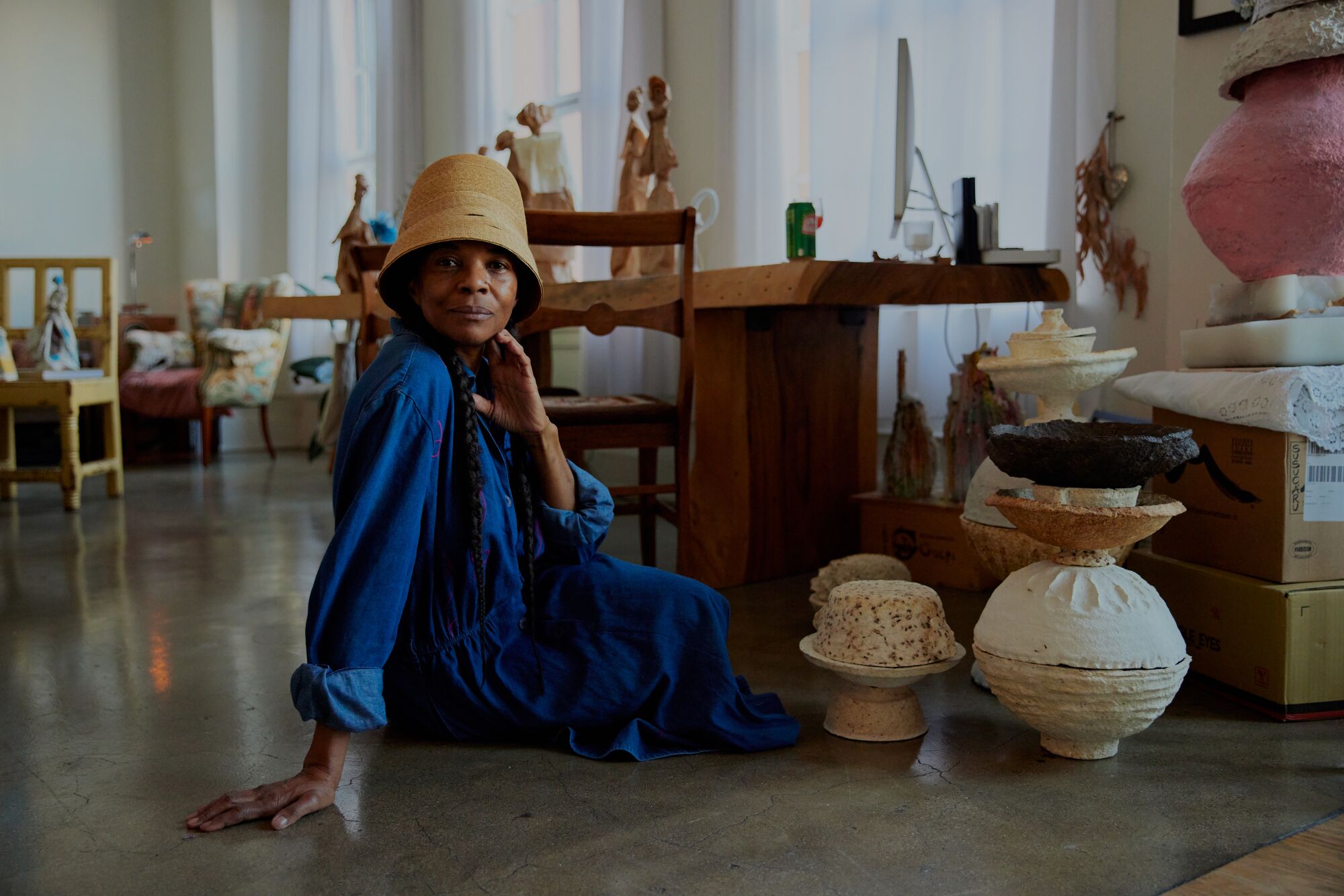
Natalia Pereira, the proprietor of the Brazilian restaurant Woodspoon, at her residence and artwork studio, AD105.
(Jennelle Fong)
“It’s the place tales, secrets and techniques are informed, the place loves are revealed, the place we eat,” chef and artist Natalia Pereira tells me in Portuguese, as she stands behind her kitchen counter. She didn’t all the time have a desk to eat at whereas rising up in Minas Gerais, Brazil. “I skilled the style of starvation many occasions, me and my brothers,” she says. “It’s an unforgettable style.” Pereira is an orphan; she remembers her early childhood along with her adoptive mom, Francisca, with intense fondness: sucking sugar canes, climbing avocado and mango bushes, heating water by the wooden range for her baths, smelling the scent of cake in her mom’s hair. However all that was taken away from her when she was seven. She describes being “kidnapped” by her “official dad and mom,” whom she lived with for 2 years earlier than shuttling between foster houses. “That’s why I prefer to welcome folks after they arrive at my restaurant. I prefer it after they eat, after they drink — eat up, woman, drink your juice!” Pereira laughs.
Sixteen years in the past, she opened the restaurant Woodspoon in Downtown L.A., an area that has turn out to be her means of representing Brazil, of providing up a reminiscence of her childhood by means of sometimes Mineiro dishes, like tropeiro beans and pork loin, or rooster and okra. Inside, the tables are sq. and wood and graced with flower bouquets that Pereira sculpted from recycled napkins. There are additionally menus with photos of greens, spoons and folks in festive attire that she drew by hand.

Natalia Pereira rolling dough for pão de queijo
(Jennelle Fong / For The Occasions)
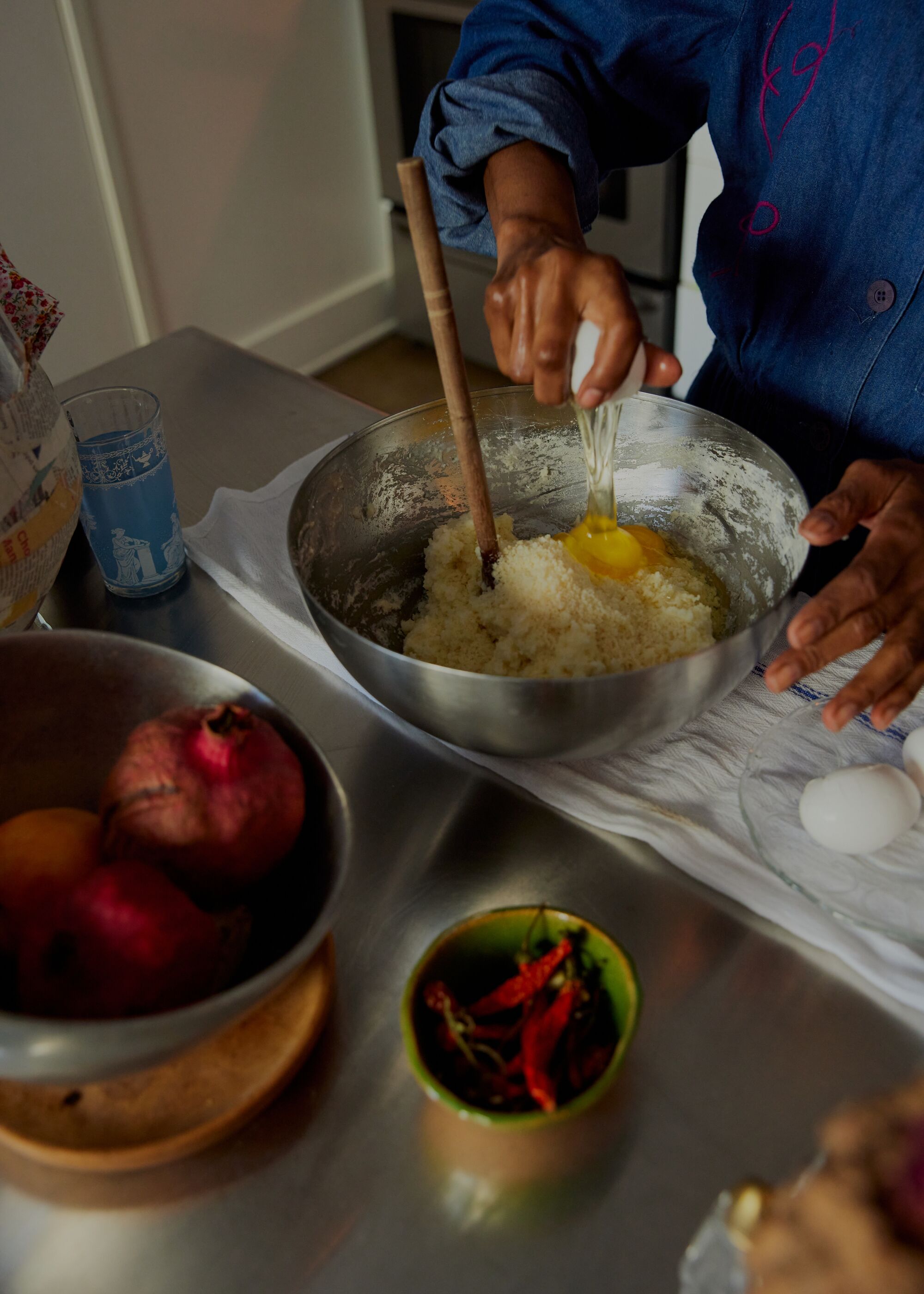
The beginnings of pão de queijo, a standard Brazilian cheese bread
(Jennelle Fong / For The Occasions)
A mesa é um altar, the desk is an altar. It means that you can give your self over to the second. The primary time I meet her at her restaurant Pereira greets me with a blended plate of typical Brazilian fried snacks — coxinha, kibe, pastel, bolinho — full of beef, cod, cream, and rooster, which I eat and wash down with a tall glass of ardour fruit juice. I’m enthusiastic about the freshly squeezed juices at my uncle’s home within the northeast of Brazil, the bolinhos I ate on the sidewalk, the paper luggage and my fingers stained with grease. Meals stylists can transport you with their work. The desk is the purpose of departure.
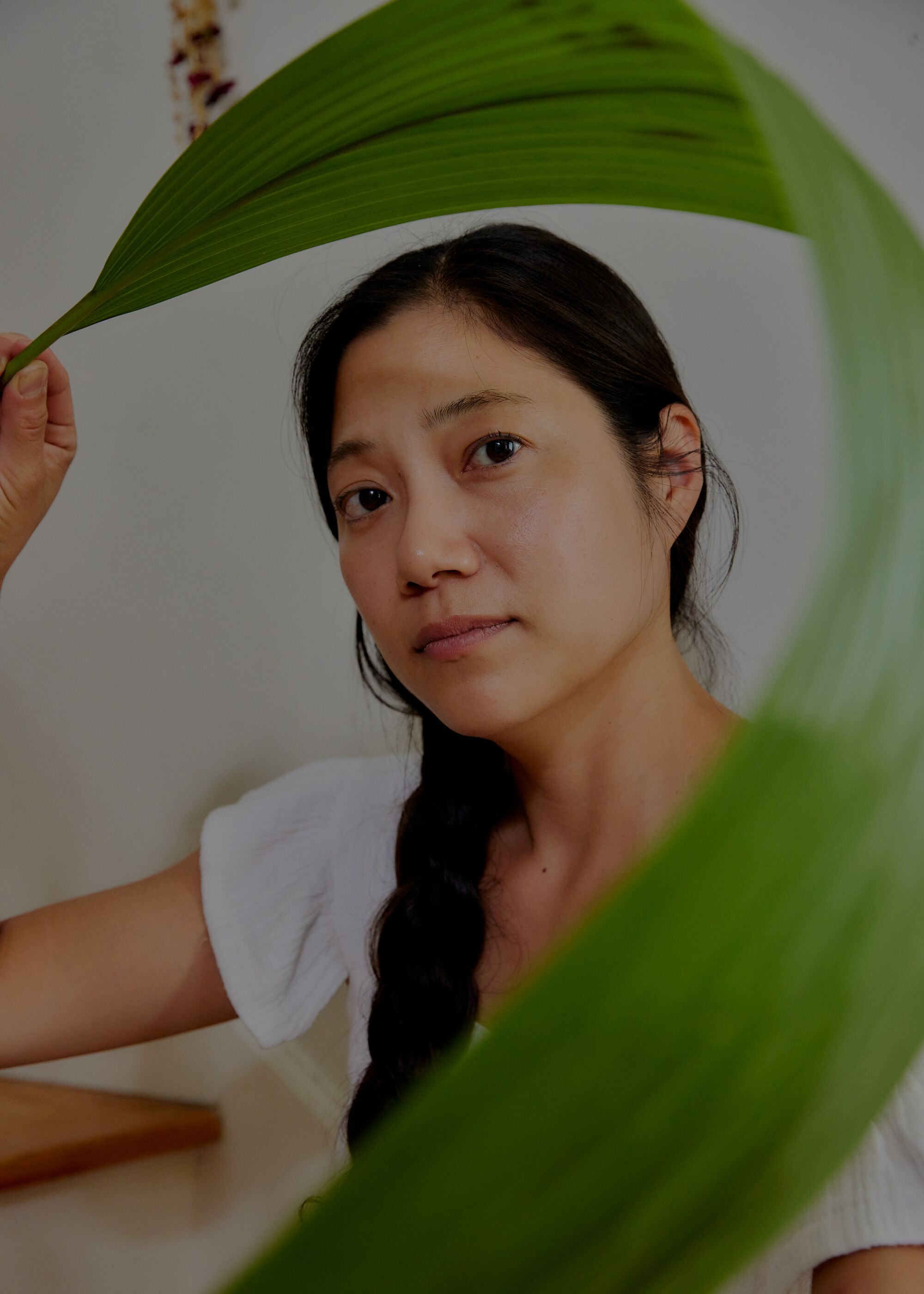
Chef and meals stylist Saehee Cho, founding father of meals subscription service Quickly Mini.
(Jennelle Fong / For The Occasions)
It’s additionally an area the place the work comes collectively. For chef and meals stylist Saehee Cho, who based the meals subscription service Quickly Mini, her out of doors wood desk is “a central level”: it’s the place she writes her poetry, fiction and essays, the place she has her morning espresso, the place mates congregate, the place 3am tarot card readings happen. Cho commonly co-hosts an occasion at Windrose Farm within the orchards of Paso Robles, the place company assist out with the farm — gardening, feeding the animals — and luxuriate in an outside meal ready by Cho. At any time when she does occasions, “it truly is simply translating the sensation that I do each different evening with my mates right here,” she says. Her mates know to skip the entrance door and go on to her yard — the place she grows her herbs and retains traces of current meals styling jobs: leftover dried peppers and flowers hold in a big internet stretched throughout the aspect of her residence. “You’re coming to a desk, you don’t actually know what you’re going to get to eat, however you realize that it’s going to be served with care and love.”
In Cho’s household, meals was “the massive communicator,” extra so than phrases. She grew up in Laguna Hills, Orange County, and spent her summers in Seoul, Korea, along with her grandmother, who was a meals stylist within the Nineteen Sixties. Cho speaks Korean, nevertheless it was meals that closed the “gaps” between languages, cultures and age variations.
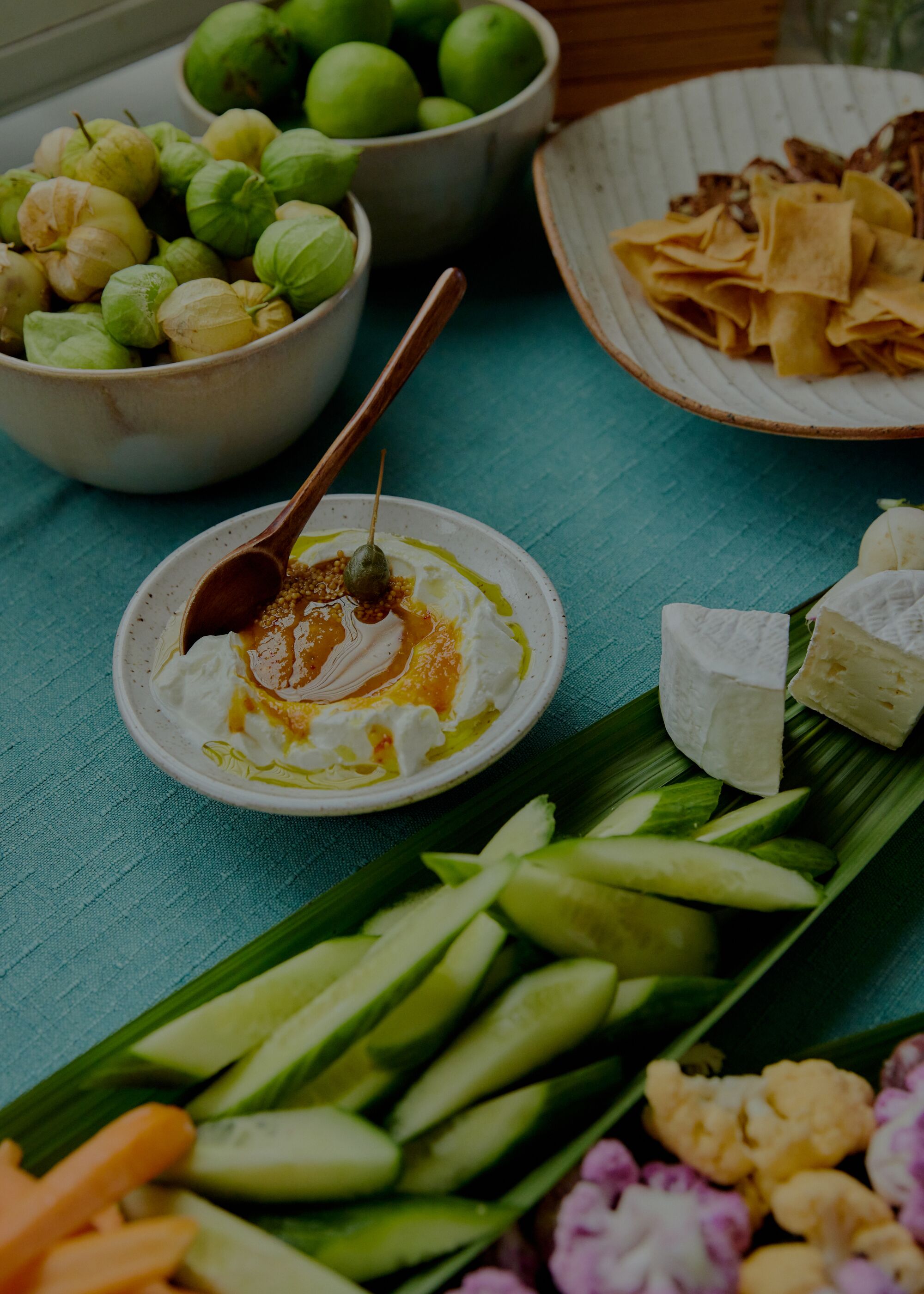
The ample unfold of sliced cucumbers, chunks of brie cheese, cauliflower florets, carrot sticks, and pita chips, paired with a creamy dip.
(Jennelle Fong)
On the day she is internet hosting me, Cho lays carrots, cucumbers, and child yellow tomatoes on lengthy inexperienced leaves within the form of canoes. It’s what she likes serving for big teams of mates — many palms reaching over one another, dipping into the identical plate. Possibly consuming turns into extra conscious when it’s communal; not solely the dish, however the desk must be thought of and shared.

Karla Subero Pittol additionally usually collaborates with native cooks, bringing of their distinctive flavors and specialties to the rotating crowd at Chainsaw. Right here, she holds an entire fish, simply earlier than marinating and grilling.
(Jennelle Fong / For The Occasions)
A desk can fill the area you may not have identified cross or take a look at. It says this area that’s mine can be yours. This can be a guideline behind Karla Subero Pittol’s venture Chainsaw, for which she hosts pop-up feasts out of her Echo Park storage. All of the tables are communal; the primary one, a protracted piece of plywood mounted on two sawhorses, is a duplicate of Georgia O’Keeffe’s desk at Ghost Ranch (the thought of Sara Marlowe Corridor, Chainsaw’s inventive director). The desk anchors the area, which feels a bit like being in Subero Pittol’s front room. (Generally she forgets that it’s a storage — till she finds the spider webs.) The decorations are private: uncooked woods and ceramics and tropical colours to remind her of her birthplace, Caracas, Venezuela. Work hold on the wall, together with one by Subero Pittol of a girl trying over her shoulder, her pores and skin principally uncovered (most of her work are primarily based on “Playboy” magazines — “so voluptuous, horny,” she says of the ladies). Utensils cluster in recycled coconut milk and lychee cans that mild up the area. All of it has the vibe of an off-the-cuff hold.
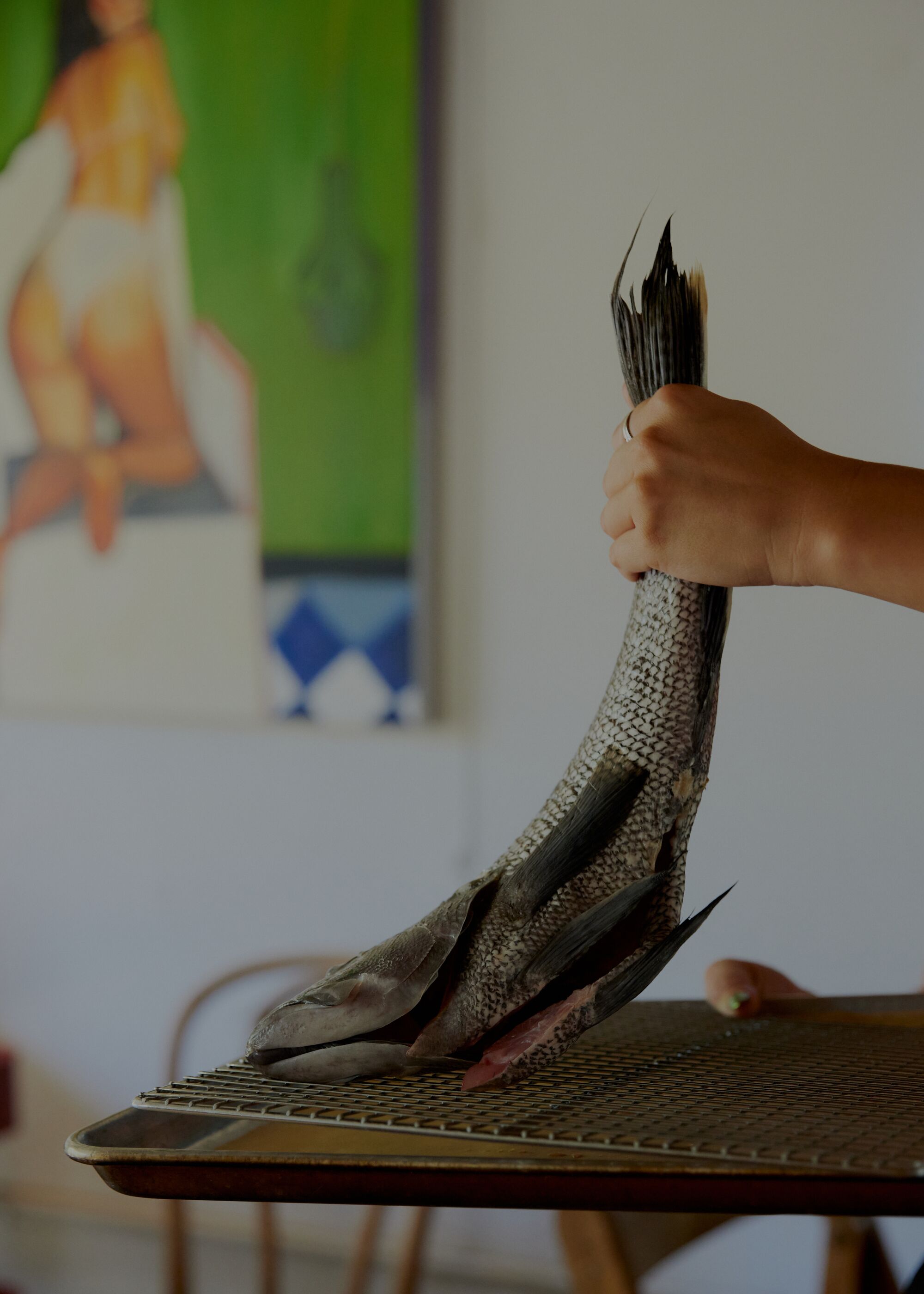
An entire fish, about to be marinated and grilled.
(Jennelle Fong / For The Occasions)
For Sandy Ho, the chef behind the pre-pandemic month-to-month dinner collection Sanditas, the desk is a spot the place “the whole lot is invited.” She owes this perspective to her dad and mom. They’re Vietnamese — they fled the Vietnam Battle — and after they settled in Belmore, Australia, they had been open and curious towards their Lebanese, Sudanese, and Korean neighbors. “Our desk by no means simply had Vietnamese meals — we’d have spring rolls with fish sauce after which lamb shanks, Lebanese bread and hummus all on the identical desk,” she says. “All the pieces was allowed on the desk.”
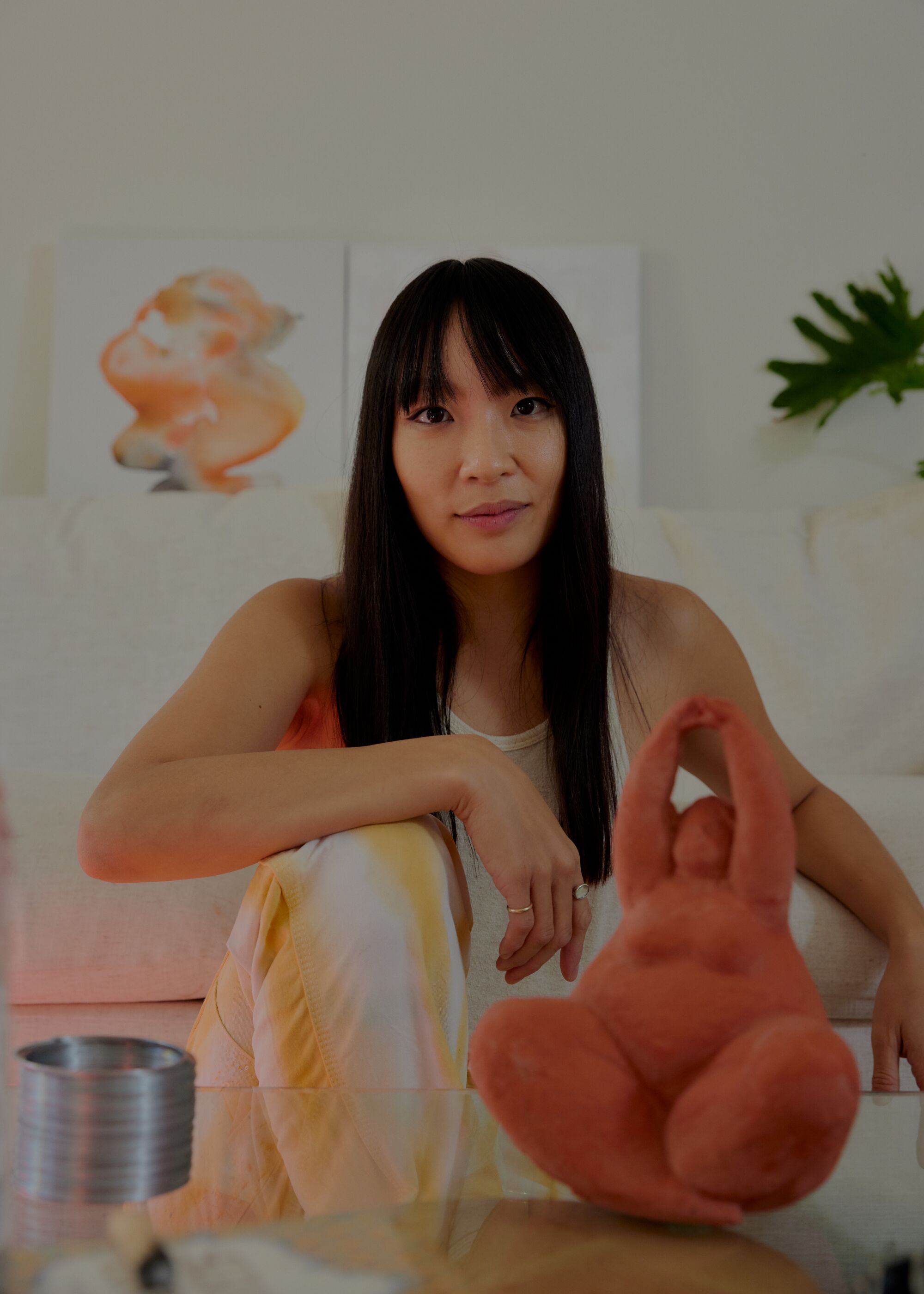
Chef Sandy Ho in her Los Angeles residence, surrounded by her portray within the background, an Aphrodite doorstopper turned collectible, and a slinky.
(Jennelle Fong / For The Occasions)
Ho — who now principally collaborates with different eating places, manufacturers and personal purchasers and does pop-ups for Sanditas — is one for a lavishly lengthy desk with a “Mad Hatter sort of unfold,” the place “one individual on the finish of desk is having to achieve over after which move this and move that.” I’m considering, once more, of the desk at my uncle’s home, the place there have been typically as much as 15 of us, at turns standing and sitting, selecting between a number of breakfast choices (ripe and underripe mango, tapioca, French bread, cheese). The perfect sort of desk offers you permission. It means that you can attain for a historical past, brings what is way close to. A desk eases you, opens your thoughts and compels you to return sit and play. “It’s the choreography that’s simply so enjoyable and magical for me,” Ho says.
Meals styling turns into its personal choreography when Ho stacks 5 white bowls precariously and whimsically excessive, packing the crowning bowl with dumplings and pouring chili over them in order that the reddish brown sauce glides down the porcelain, on to the tablecloth, messy and fantastically irreverent. Or when Cho separates her greens by hue — a Korean shade idea that enables every merchandise to have its “personal second,” like dancers on a stage, every merchandise expressing what went into its existence.
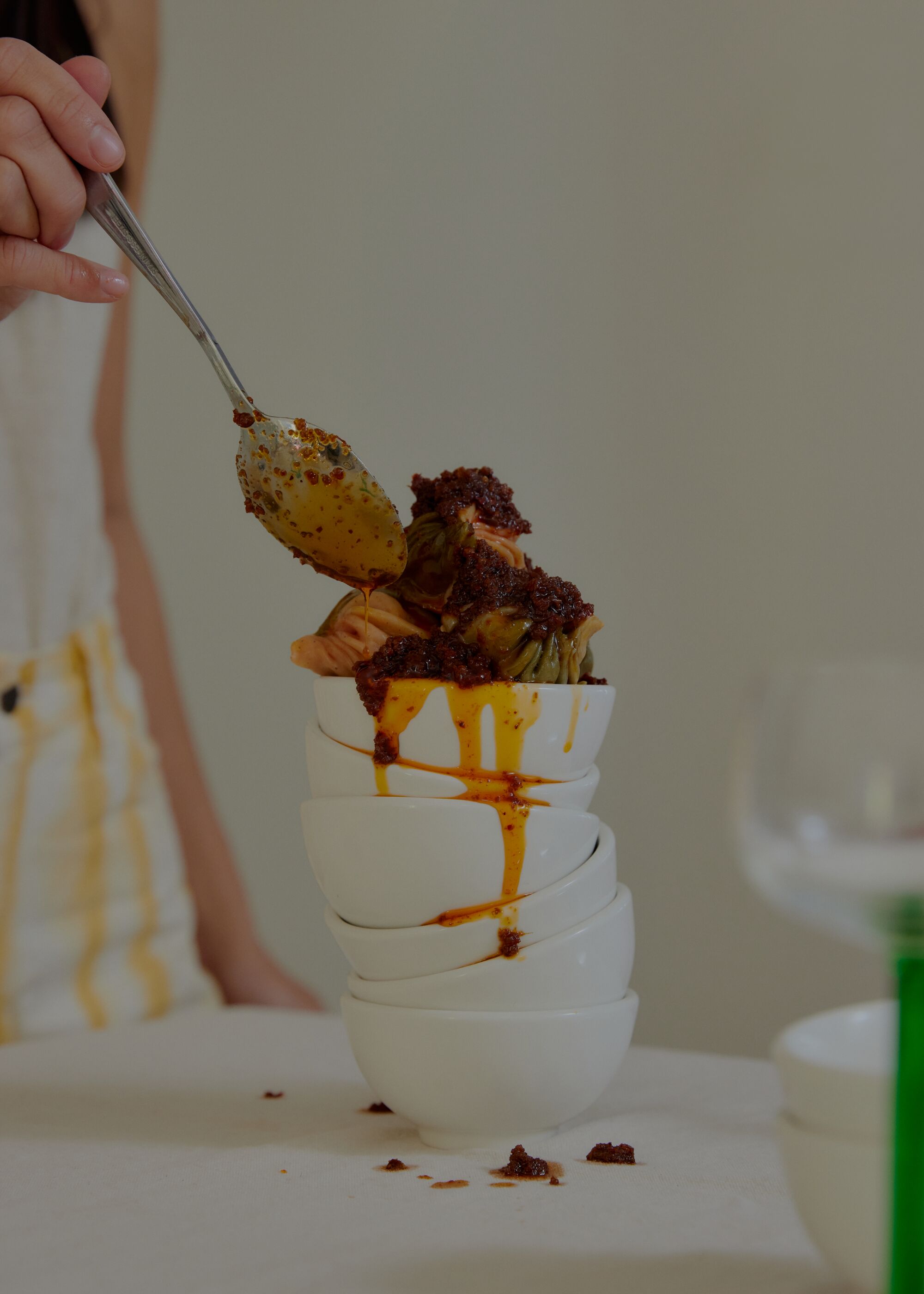
Sandy Ho tops off a bowl of dumplings along with her shallot and garlic chili oil.
(Jennelle Fong / For The Occasions)
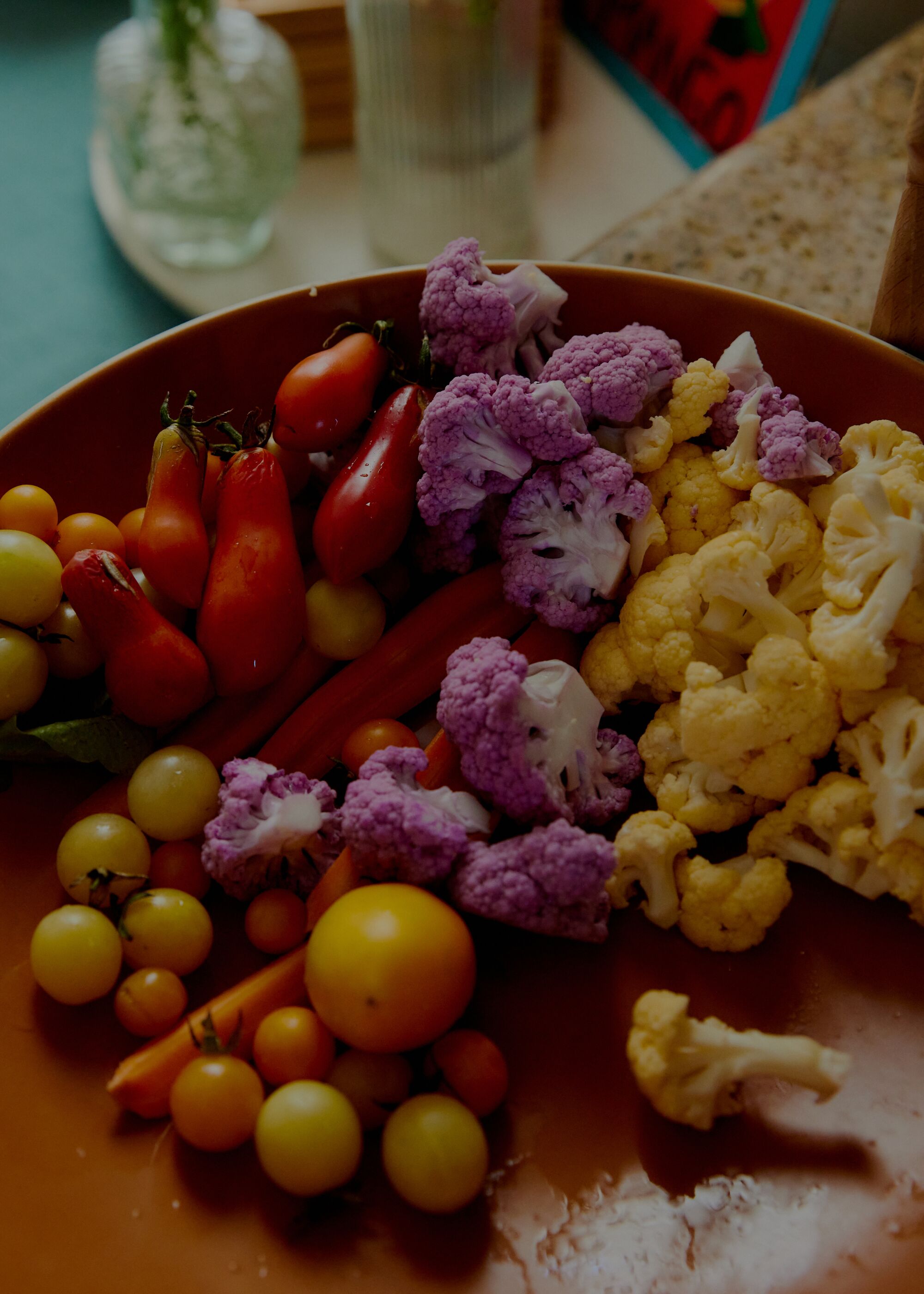
A bowl of farm recent tomatoes, carrots, and cauliflower florets.
(Jennelle Fong / For The Occasions)
The labor that goes into deciding on, cooking and arranging meals can have a grounding impact. After working at Woodspoon from eleven within the morning to midnight, Pereira arrives residence drained, smelling of garlic and with oil in her hair, and makes sculptures from leftover substances within the kitchen: the determine’s our bodies are sure by flour and water, their attire adorned with fennel seeds, their jewellery assembled from espresso and chocolate. She needs to offer these substances an afterlife, distilling paints from beets, carrots, and crushed flowers to create floor-to-ceiling work of joyous women holding overflowing bouquets and emerald-green purses.
“Meals talks with me,” Pereira says. “Now we have our intimacies, substances and I.” When she’s cooking, she feels “honored, vital.” “It’s a religion,” she says. “I see miracles. To know that we’re in a position to create, that the earth gave us all this, that we’re in a position to create taste, that we’re in a position to create a palate, that we’re in a position to go away behind reminiscences…”
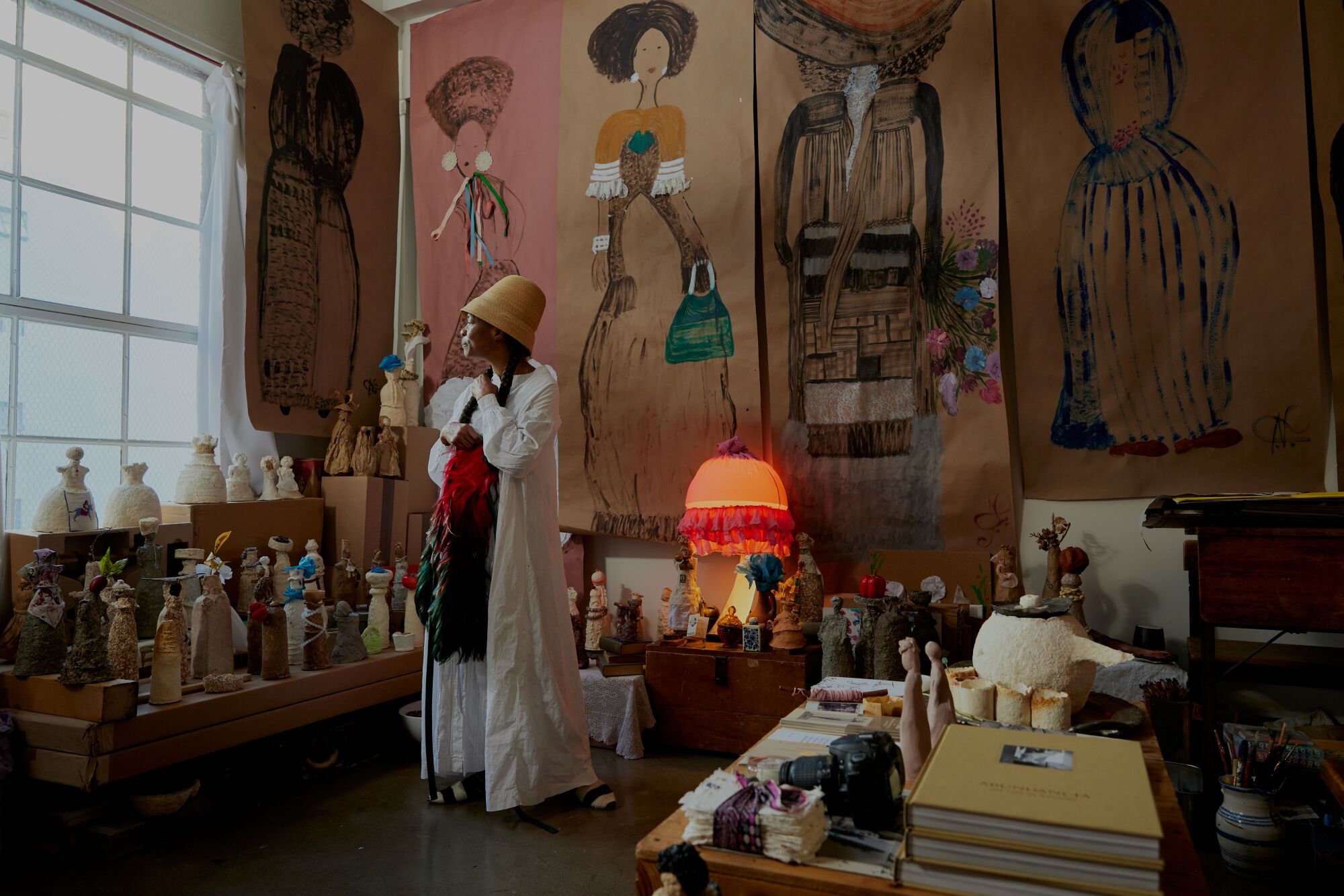
Natalia Pereira in her intimate studio AD105. The area is crammed along with her sculptures, work and vessels.
(Jennelle Fong / For The Occasions)

Natalia Pereira
(Jennelle Fong / For The Occasions)
Pereira’s intimacy with meals is about an intimacy with the earth, with the bodily world. As she writes in her e-book “Abundancia,” life is fabricated from this. “The best way I do my hair, the best way I costume, the best way I reduce kale, the best way I take advantage of garlic and salt, the best way I tuck rue behind my ear” — it’s all related, she says.
Pereira doesn’t use recipes. She — like her mom, Francisca — has by no means owned a measuring spoon. Pereira prefers an unmediated relationship along with her substances: “Meals communicates in a pure means.” Pureness elements into her artworks as nicely. Pereira doesn’t sketch her artworks; she paints instantly on the paper and builds her bowls and sculptures along with her palms. With regards to her work — whether or not a dish of rooster and manioc fries or a paper doll sure with string or considered one of her bowls made with blueberry seeds and thousand-year-old roses — you’re feeling nourished by the care she places into it.
For meals stylists, contact additionally guides them of their course of — it connects them to the work. Ho makes use of her assortment of rocks for instance — “there’s one thing so tactile about these objects,” she says, evaluating them to chopping open a delicata squash bursting with seeds and an electrical orange. On her desk unfold, Ho scatters a few of her rocks: the rosy one that appears like a slab of bacon, the grey one which softly glitters throughout, the stone that turns a deep orange when coated in water.

Tender rooster with charred cabbage, topped with Sandy Ho’s mother’s curry — a sauce on each menu of her dinner idea Sandita’s. Diminished for over 8 hours from a home made pink curry paste, this curry is a model of the basic Vietnamese cà ri gà.
(Jennelle Fong / For The Occasions)
There’s a phrase in Korean, 손맛 (son-mat), that actually interprets to “hand style,” Cho says. “It’s the concept the cook dinner who has expertise will deliver that additional seasoning … It’s the sort of factor that will get translated out of a recipe — the best way you’re feeling the load of sugar or the load of flour, versus measuring it.” You must contact the meals together with your palms to “take up it.”
Ideally, Cho is aware of all of the palms which have touched her meals, particularly the individuals who grew and tended to it. “A carrot is a carrot, however a carrot that I do know Andrew grew or that I do know that this season it was exhausting to develop as a result of there was an absence of water, and that’s why it’s formed like this — that’s what offers the factor one thing additional from me,” she says. “As a result of that creates the narrative that creates worth.”
On my visits to every chef’s residence, I watch them dig their palms into dough. Lick the sauce off their fingers. Slice right into a fish. Collect bundles of purple cauliflower into their palms. They’re unafraid of their substances; they really feel them, lean into them.
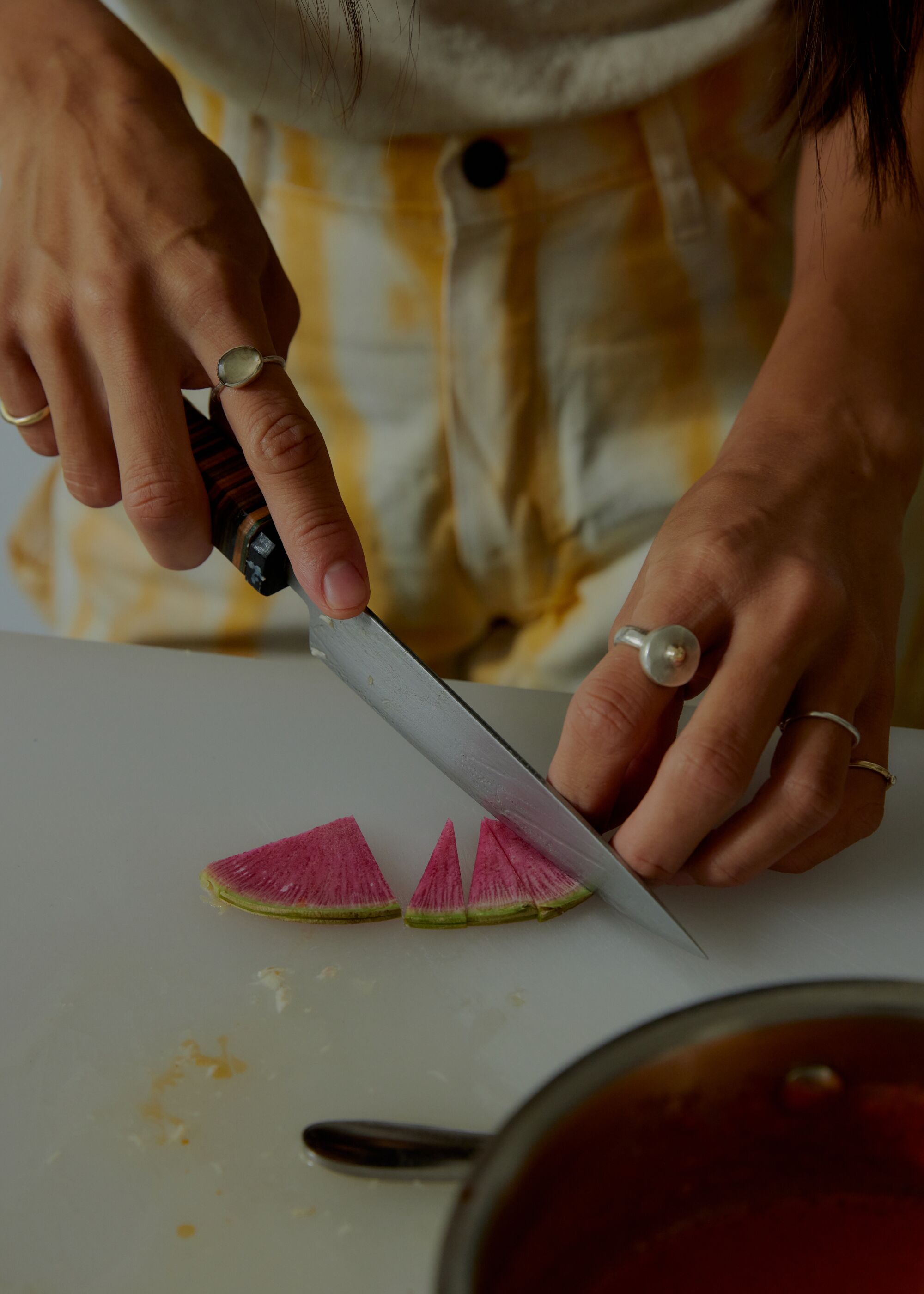
Watermelon radish, reduce in petite triangles, as a topping for Ho’s fish sauce congee.
(Jennelle Fong / For The Occasions)
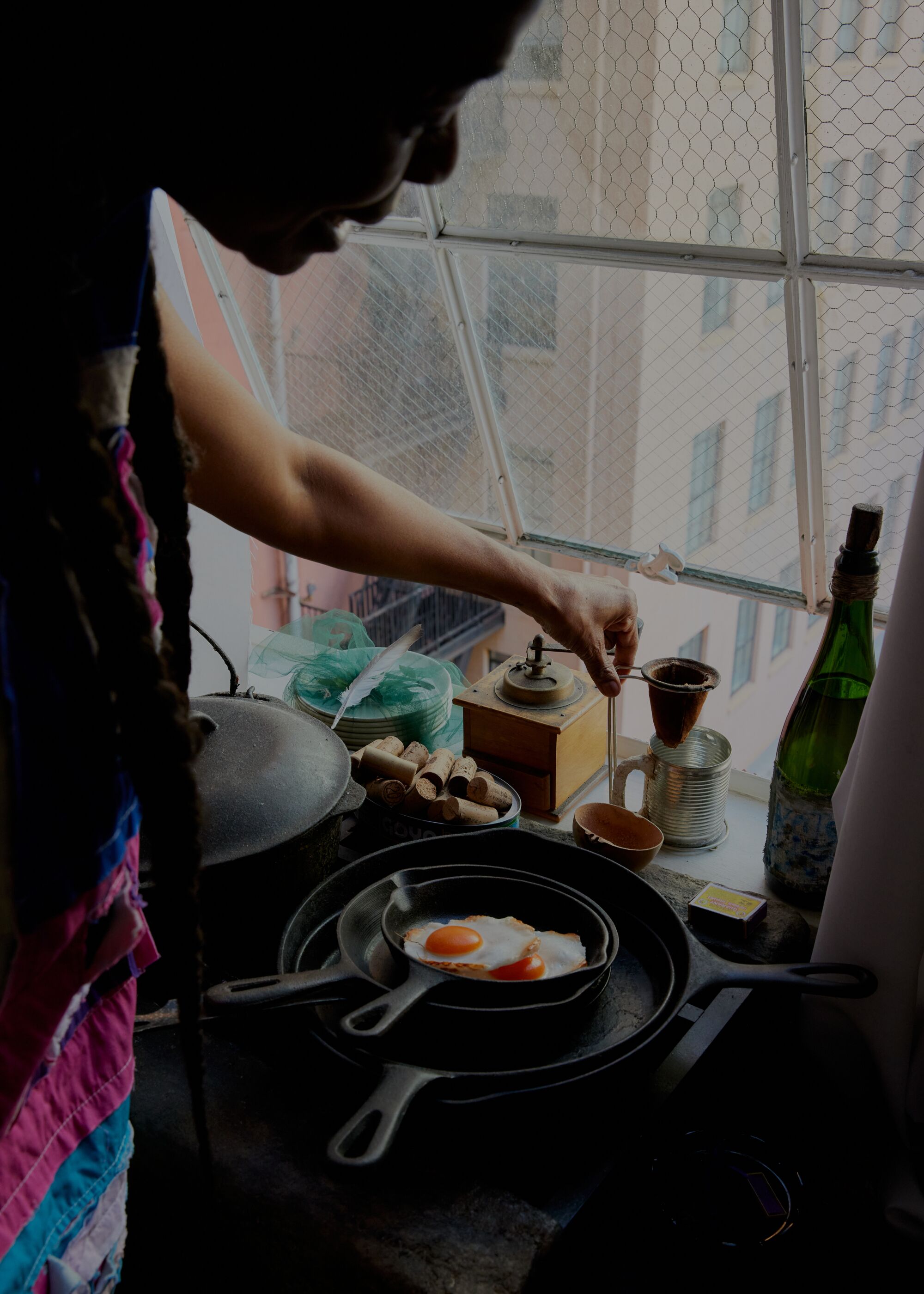
Pereira with a bit from her art work “Reminiscence-Materials,” which confirmed on the Geffen Up to date at MOCA in June 2022.
(Jennelle Fong / For The Occasions)
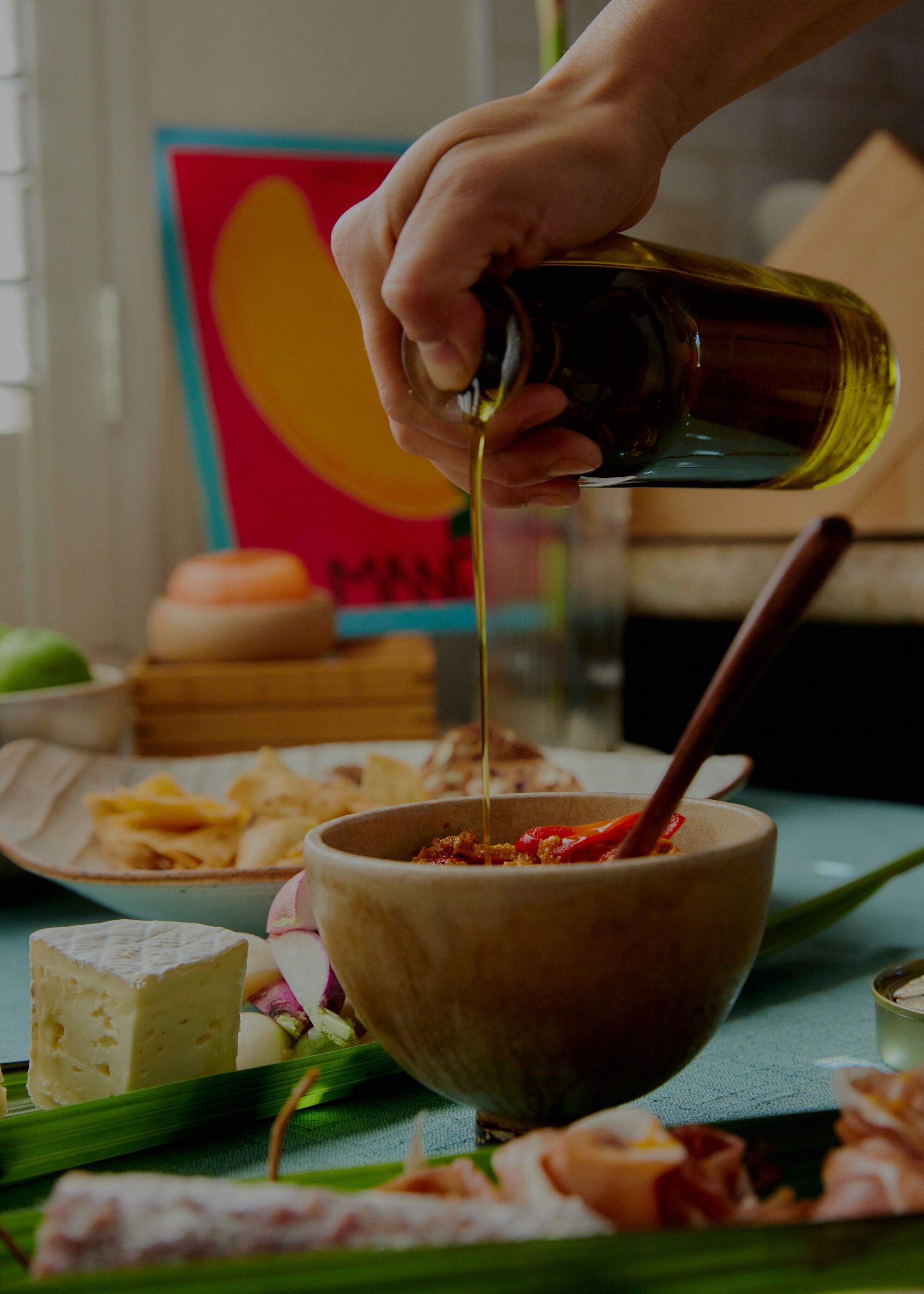
A wholesome replenishing of olive oil at Saehee Cho’s desk.
(Jennelle Fong / For The Occasions)
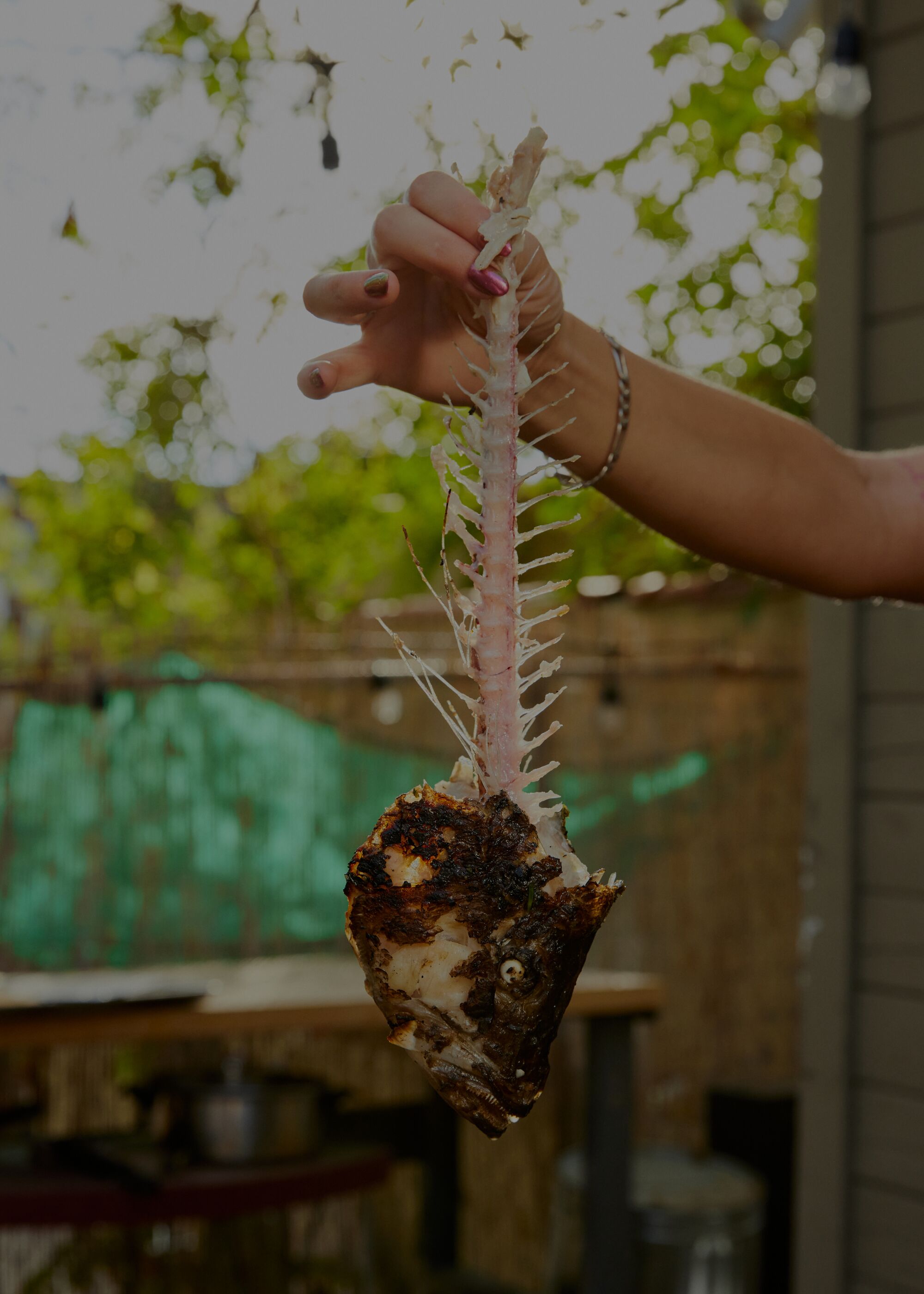
Karla Subero Pittol holds the fish after serving.
(Jennelle Fong / For The Occasions)
Cooking is effort. In Subero Pittol’s storage, I watch her sprint between her smoking wooden oven, fridge, and desk (whereas carrying a bodysuit to include the sweat). She kilos herbs and garlic oil, flips the seabass over flames, squeezes the tart tangerine in her hand. The desk turns into a sort of help, withstanding all that chopping and urgent and weight. Subero Pittol says she will get “completely misplaced” in her head whereas cooking. “It’s the identical form of zone that I get into when portray one thing,” she says. “It’s simply tremendous hyper-focused creation mode.”
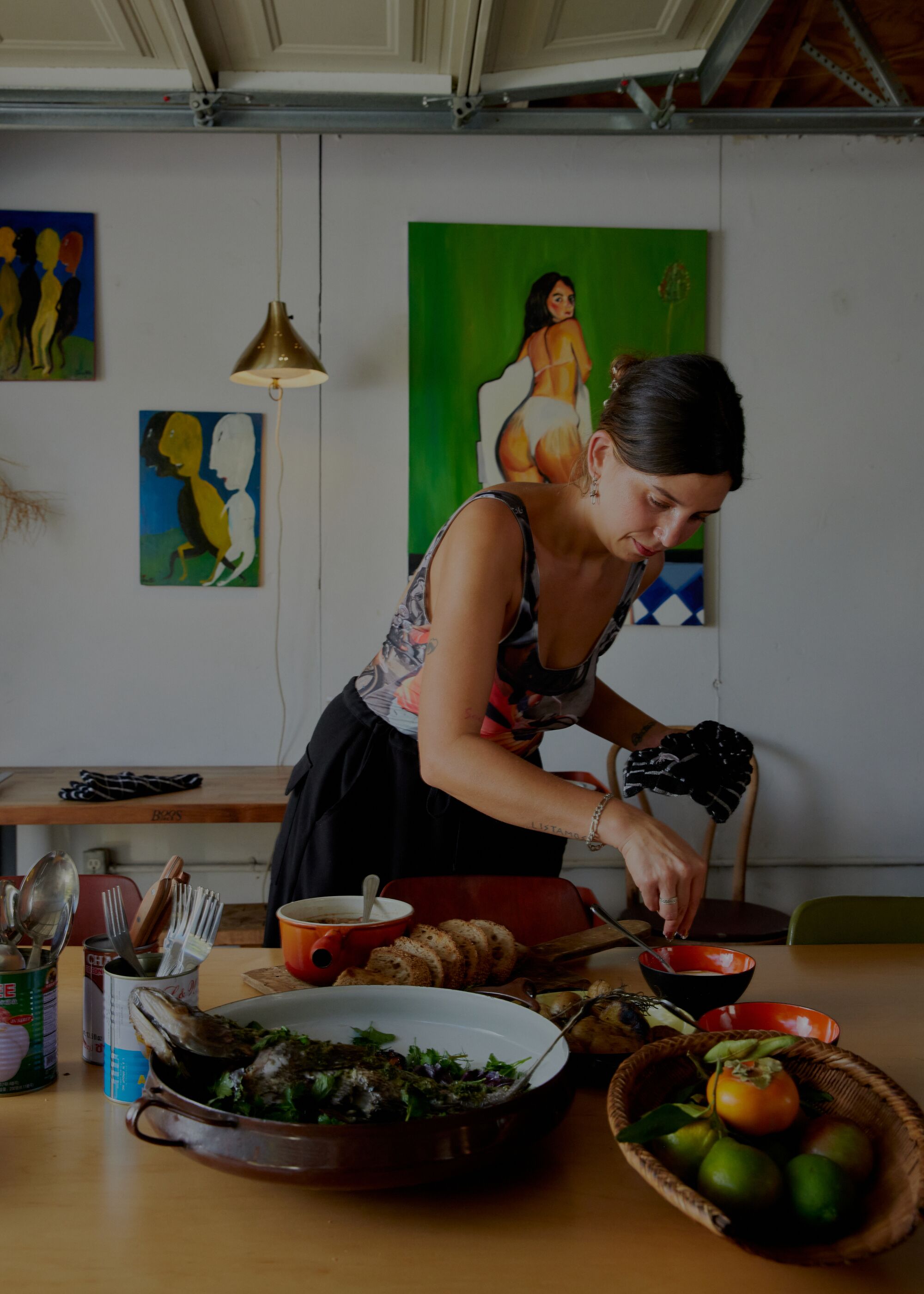
The complete unfold, simply earlier than Subero Pittol provides within the closing spices and herbs.
(Jennelle Fong / For The Occasions)
Subero Pittol has been portray since she was youthful. When she first began cooking, she checked out her artwork historical past books for inspiration — Bacon, Miró, Picasso. “I’d take a look at a shade scheme after which sort of think about what greens would make that shade,” she says. “I nonetheless sort of do this.”
Ho additionally studied tremendous artwork earlier than changing into a chef — she first envisions no matter she goes to cook dinner when it comes to shade, when it comes to an image. Propped behind Ho’s sofa are two of her work: washes of oranges, blues, and pinks over white backgrounds. She compares them to her mesmerizing, multicolored dumplings, which she makes by folding pigments extracted from spinach, squid ink, pink pitaya and turmeric into the dough. The result’s as a lot a shock as her summary canvases.
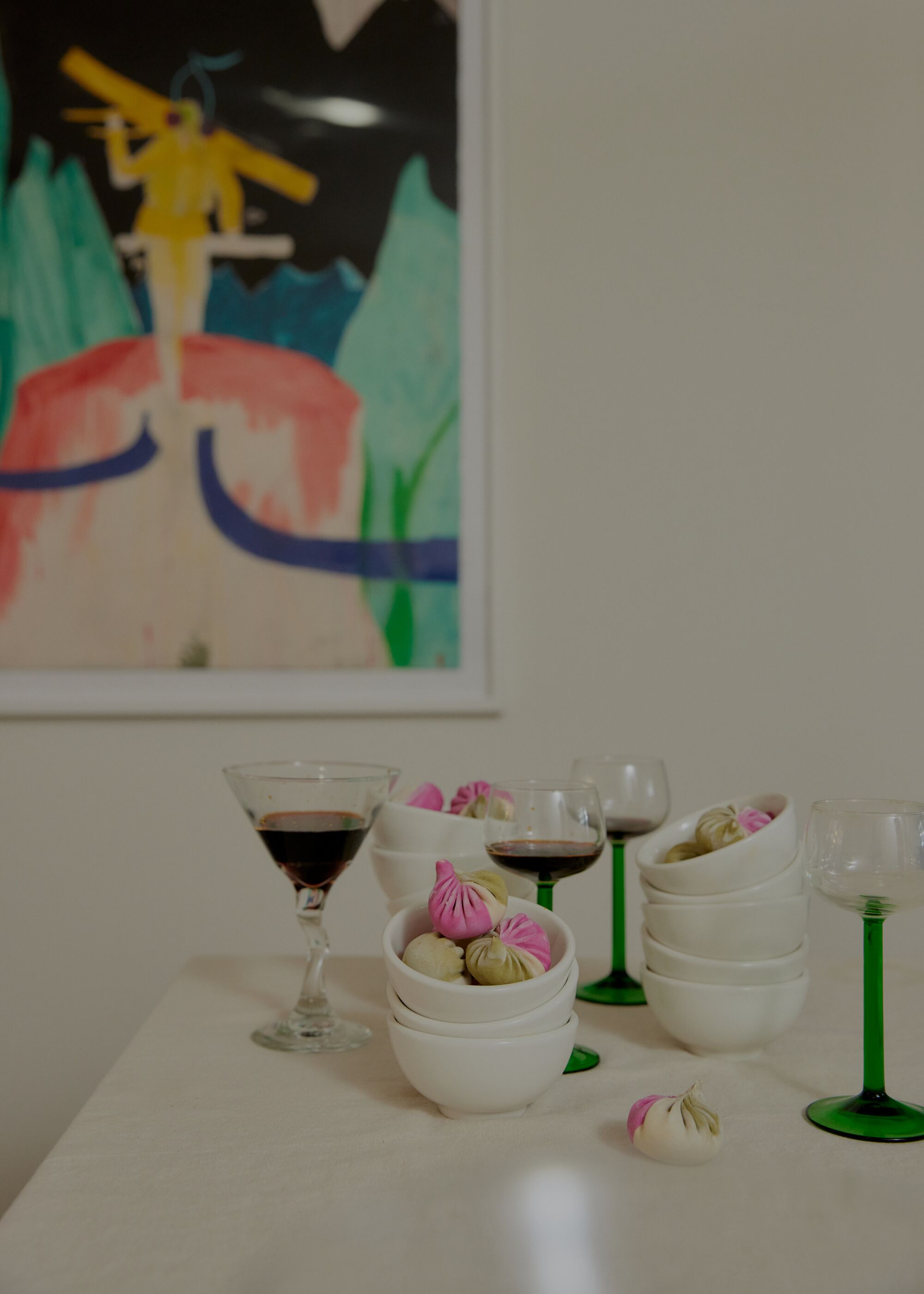
A sculptural providing of dumplings inside stacks conventional of rice bowls, with accompanying glasses of soy sauce.
(Jennelle Fong / For The Occasions)
The hassle that goes right into a meal is like composing a portray in that you simply’re pouring your self within the work. It’s this effort that makes the meals or image extra vibrant, extra current, extra alive. A dish is sort of a portray which is sort of a poem, a rock, part of an individual, an providing to you.
The sensory expertise of eating — a mouthful of pork dumpling, the remnants of smoke from a wooden fireplace — connects you with the current. However meals additionally serves as a relentless reminder of the previous — that you would be able to entry it at any level. A chunk of Subero Pittol’s meals takes her to the primary time she ever tasted what she’s consuming — together with what the setting smelled like, who she was with and what they had been carrying. Ho’s rooster is made along with her mother’s Vietnamese coconut curry — cooked for at least 8 hours — that she splashes on the whole lot. The meals that these ladies make transport them by means of time, and nearly all the time to their households. “Meals, I feel, for lots of people is nostalgic,” Cho says.
As a result of my household commonly moved round, the meals we ate additionally shifted, however we stored our staples — cooked kale, farofa (toasted yucca flour), and rice (all the time a lot rice). Throughout the seven flats and homes I grew up in, it’s the area of the eating desk that I keep in mind greatest, the area that by some means felt the identical in every new surroundings, set with deep blue placemats and a jug of water with a inexperienced flower for a bottle stopper. Possibly that’s what it means to discover a “stable desk” — a desk that holds your actuality true, sustains it.
At Pereira’s home, she makes pão de queijo, or a Brazilian cheese bread, served scorching and as particular person, hand-sized balls (a snack I ate on the mall each week with my mother once we lived in Brazil). Her mother used to offer her the leftover dough and Pereira would roll it into tiny balls and play. Its base, flour, can be the stuff of her artwork — “it’s the shape that unites the whole lot,” she says.
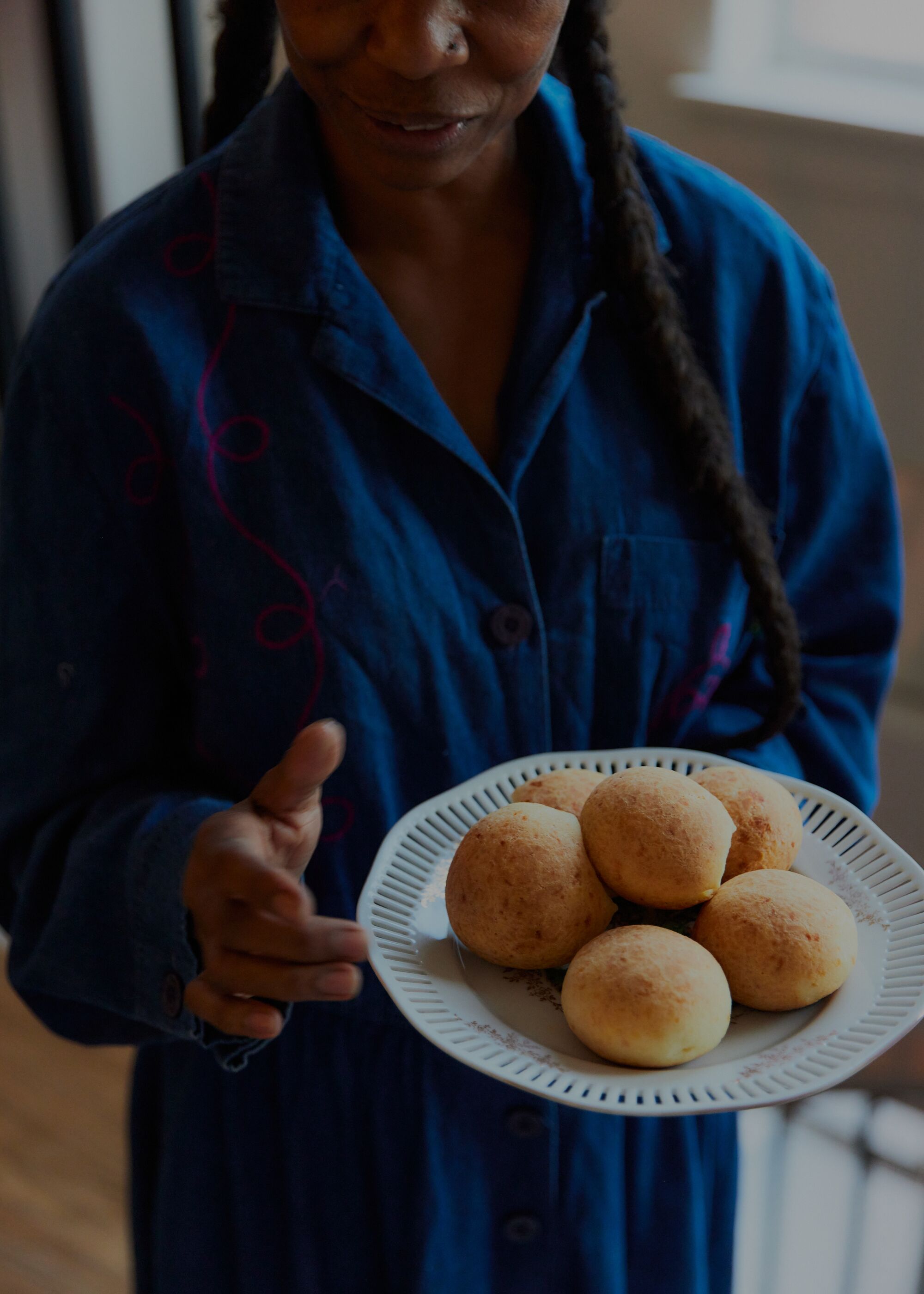
A plate of pão de queijo, recent out of the oven.
(Jennelle Fong)
Pereira wouldn’t essentially say that pão de queijo reminds her of residence, as a result of she didn’t translate what residence meant to her till comparatively just lately. “I’ve all the time had this urge for food, this longing to know, what’s a house?” she says. However that modified when she began spending on daily basis elbows-deep in flour, her palms caring for meals and artwork, reveling in that palpable second on the desk of making one thing new that she will be able to contact, maintain, and style. “Lastly, I’ve a lover, I’ve survival.”
Extra tales from Picture




